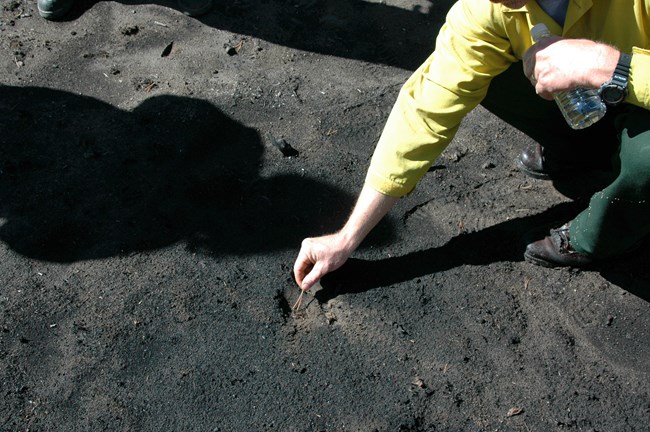
This is because loss of vegetation may cause erosion that reduces soil productivity and increased runoff may cause flooding that affects homes, facilities, reservoirs, roads, bridges, and habitat. In severe cases, land managers prescribe emergency stabilization actions.
Important Links
However, in most cases, the National Park Service prefers to allow natural processes to occur. When intervention is necessary, NPS land managers select the most cost-effective alternative with the greatest potential for success to meet land management objectives.
-
BAER - Burned Area Emergency Response
BAER, or Burned Area Emergency Response gives nature and communities a head start to recovering from a massive wildfire.
- Duration:
- 3 minutes, 4 seconds
Burned Area Emergency Response (BAER)
The Burned Area Emergency Response (BAER) Program is an emergency program to identify imminent post-wildfire threats to human life and safety, property, and critical natural or cultural resources and, when possible, take immediate actions to manage unacceptable risks.
BAER is part of the whole spectrum of post-fire emergency response that includes fire suppression damage repair, post-fire rehabilitation, and long-term fire restoration. BAER resources are prioritized primarily on the direct impacts of the fire itself, and the post fire watershed impacts on values at risk. Values at risk may include human life, property, natural resources, historic properties, threatened and endangered species, potential for exotic invasives, soil productivity and Native American or other cultural values. Once identified, values at risk should be evaluated for appropriate emergency stabilization action. These evaluations may require coordination with local specialists and appropriate models should be used and referenced.
Assessments are usually completed within 5 to 10 days, depending on the size of the fire. Treatments and actions are done immediately to prevent or minimize additional damage.
Typical treatments and activities include:
- Placing structures to slow soil and water movement
- Increasing road drainage frequency and/or capacity to handle additional post-fire runoff, for example, modifying culverts to allow for increased flows
- Stabilizing soil to prevent loss or degradation of productivity, such as by applying mulch on hillslopes to minimize soil erosion and runoff
- Stabilizing or removing hazardous material to prevent mobilization into surface water
- Stabilizing cultural sites and critical heritage resources to prevent erosion
- Patrolling, camouflaging, or burying significant heritage sites to prevent looting
- Closing areas to public use
- Posting warning signs in burned areas
- Fencing off safety hazards (e.g., newly exposed mine shafts or adits)
- Installing protective fences or barriers to protect treated or recovering areas
- Replacing or repairing minor facilities essential to public health and safety when no other protection options are available
- Conducting assessments of critical habitat and significant heritage sites in those areas affected by emergency stabilization treatments
- Seeding or planting to prevent permanent impairment of designated critical habitat for federal and state listed, proposed, or candidate threatened and endangered species
- Using integrated pest management techniques to minimize the establishment of nonnative invasive species within the burned area
- Seeding native species or noninvasive cultivars to prevent spread of invasive plants
- Monitoring treatments and activities for up to three years
The National Park Service works closely with other federal cooperators such as the USDA Forest Service, the Bureau of Land Management, the Bureau of Indian Affairs, and the US Fish and Wildlife Service. The USDA Natural Resource Conservation Service (NRCS) Emergency Watershed Protection (EWP) program plays an important corollary role on nonfederal land in providing flood prevention assistance to private landowners. The National Weather Service plays a key role in public notification about storms, flash floods, or potential for landslides.
Burned Area Rehabilitation (BAR)
The BAR program provides funding for non-emergency post-fire rehabilitation and vegetation restoration projects. The intent is to improve lands directly damaged by a wildfire or to restore or establish healthy, stable ecosystems in the burned area. Common treatments include:
- Chemical, manual, and mechanical removal of invasive species
- Planting of native and nonnative species to restore or establish a healthy, stable ecosystem
- Reestablishing burned habitat
- Reestablishing native tree species lost in fire
- Repairing or replacing fire damage to minor operating facilities such as campgrounds, interpretive signs and exhibits, shade shelters, fences, and wildlife guzzlers
Rehabilitation may not include the planning or replacement of major infrastructure, such as visitor centers. The funds are competitively distributed and limited by the amount that is appropriated.
Last updated: December 6, 2023

